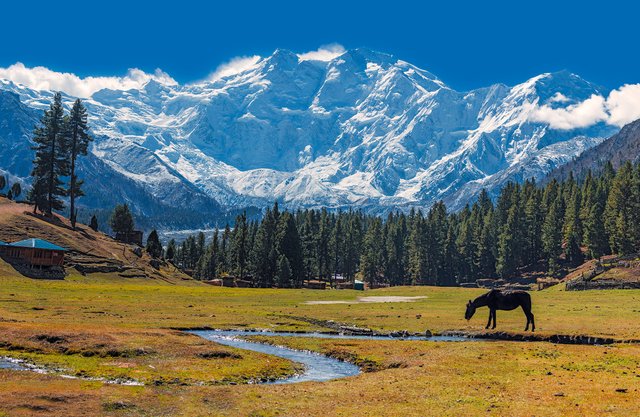
Nanga Parbat, known as the "Killer Mountain," is the ninth-highest mountain in the world, standing at 8,126 meters (26,660 feet) above sea level. Located in the Diamer District of Pakistan's Gilgit-Baltistan region, it is part of the Himalayan mountain range. The name "Nanga Parbat" translates to "Naked Mountain" in Urdu and Hindi, reflecting its sheer slopes and treacherous terrain.
Geographical Features
Nanga Parbat is renowned for its dramatic and varied topography. The mountain features three main faces: the Rupal Face, the Diamir Face, and the Rakhiot Face, each presenting unique challenges to climbers. The Rupal Face, often referred to as the highest mountain face in the world, rises approximately 4,600 meters (15,000 feet) from base to summit, making it a daunting ascent. The Diamir Face is the more commonly climbed side and is known for its relatively safer route compared to the steep, icy challenges presented by the Rupal Face. The Rakhiot Face is another formidable side that adds to the mountain's notorious reputation.
Climbing History
Nanga Parbat has a rich and often tragic climbing history. The first successful ascent was made by Austrian climber Hermann Buhl on July 3, 1953, via the Rakhiot Flank. Remarkably, Buhl completed the climb solo and without supplemental oxygen, making it one of the most extraordinary feats in mountaineering history. Before this, several expeditions had ended in disaster, including a notorious attempt by German climbers in the 1930s, which resulted in multiple fatalities. Due to its difficulty and the high number of climber deaths, Nanga Parbat is often considered one of the deadliest of the eight-thousanders, alongside K2 and Annapurna.
Challenges and Risks
The moniker "Killer Mountain" comes from the numerous lives lost during attempts to scale it. Nanga Parbat's challenging weather conditions, steep slopes, and high-altitude technical difficulties pose significant risks to climbers. Avalanches, unpredictable weather, and crevasses are common hazards. The mountain is particularly notorious for its swift and severe weather changes, which can trap climbers and lead to life-threatening situations.
Cultural Significance
Nanga Parbat also holds cultural significance for the local communities living in its shadow. The indigenous people of the region, such as the Diamer and Dard tribes, have their own myths and legends surrounding the mountain, viewing it as both a symbol of natural beauty and a powerful, almost mystical force. The mountain is a significant attraction for tourists and mountaineers, contributing to the local economy through adventure tourism.
Conclusion
Nanga Parbat remains a compelling yet perilous destination for climbers from around the world. Its dramatic features, rich history, and extreme challenges continue to draw both admiration and caution from the global mountaineering community. As one of the highest and most dangerous peaks in the world, Nanga Parbat is a testament to both the allure and the danger of high-altitude climbing.
"WOW! 🤩 This post is an absolute masterpiece! The stunning photo of Fairy Meadows and Nanga Parbat is breathtaking, but it's the wealth of information that truly makes this a standout piece of content. I've learned so much about one of the most impressive mountains in the world - from its geographical features to its climbing history. Kudos to you for sharing your knowledge with us! 🙌 I'm definitely going to share this post with my fellow adventure-seekers and Steem enthusiasts. Let's keep the conversation going in the comments below! 🤗 And as always, don't forget to vote for @xpilar.witness at https://steemitwallet.com/~witnesses - every vote counts, and it helps us continue creating a better ecosystem for all of us!"
Downvoting a post can decrease pending rewards and make it less visible. Common reasons:
Submit